The Search of Origins
A fascinating blend of bona fide history alongside historical fiction, these books peel back the past and insist on origins. Whether it’s a comb through archaeological artifacts or an investigation into the unresolved psychological baggage of a single life, they’re fascinated with history’s layered meanings and seek to suss out the truth of who we are and where we came from.
The Murderer’s Maid
A Lizzie Borden Novel

Erika Mailman
Bonhomie Press
Hardcover $25.00 (398pp)
978-0-9970664-4-9
Buy: Local Bookstore (Bookshop)
Erika Mailman’s kaleidoscopic narrative melds true crime, historical fiction, and elements of a psychological thriller, all hinging on a singular question: “Who isn’t a survivor from the wreckage of childhood?” To answer that question, The Murderer’s Maid, a Lizzie Borden novel, returns to the scene of the famous ax murders in a story that parallels the past with the present.
Two protagonists work in concert to navigate Mailman’s world. Chapter to chapter, perspectives shift as the setting alternates between the late-1800s Bridget Sullivan, the Borden family’s Irish immigrant maid, and 2016’s Brooke, a Latina graduate of the foster-care system who’s convinced she’s barely one step ahead of her would-be murder. Though there’s more than a century between them, Bridget and Brooke are bonded by circumstances: the paranoia and uncertainty of their living situations, their experience as immigrants, and their life-altering proximity to horrific violence.
While Bridget’s story begins several years before the famous ax murders and works its way toward the trial’s aftermath, Brooke’s begins with death and navigates the ominous territory of living out from under the shadow of crime. What’s interesting is their perspectives as intimate outsiders and witnesses. Both know more than anyone else, but what they know is always less than it takes to understand what they’ve seen. As if these parallels weren’t rich enough, Mailman eventually joins their narratives in a surprising twist of either epigenetics or karma.
Whether it’s the nails securing the door between Lizzie’s bedroom and her parents’, or a naive child’s glimpse of adults creating breaches that can never be repaired, Mailman probes the precedents of her opening question. Despite the unavoidable bleakness, her answer is surprisingly full of hope and illustrates how diverse and complex life’s journey can be when people have a will to survive.
LETITIA MONTGOMERY-RODGERS (October 27, 2017)
Wonders Will Never Cease
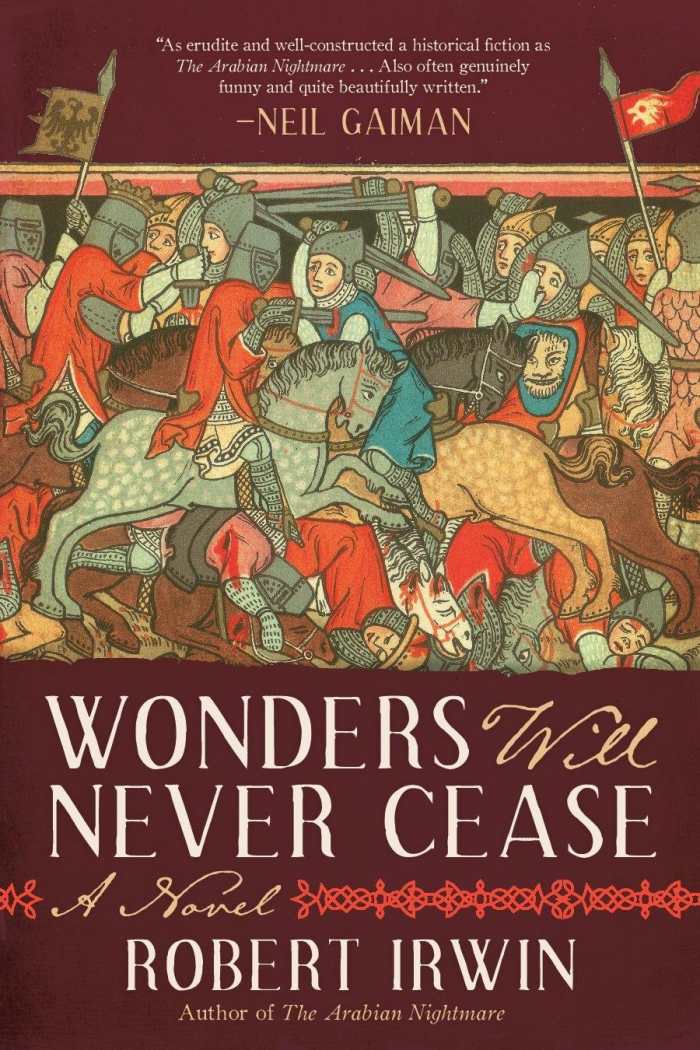
Robert Irwin
Arcade Publishing
Hardcover $25.99 (392pp)
978-1-62872-863-7
Buy: Local Bookstore (Bookshop)
A literary fantasy, Robert Irwin’s Wonders Will Never Cease delves into the War of the Roses and enters a world where “genealogy and heraldry are the only two sciences worth knowing.” Chivalry and political expediency coexist with dreams and visions, and the struggle for life is a battle waged waking or sleeping. As one young knight soon discovers, in this historic game of thrones, fortunes are made and lost on a person’s ability to survive his own legend.
Yorkist Anthony Woodville, Lord Scales, emerges from the Palm Sunday Battle of Towton as a latter-day Lazarus. Presumed dead for three days, he wakes in a dank church, having narrowly escaped burial alive due to the frozen ground. Thus, he discovers a Lancastrian on the throne and the Yorkist claim lost. Survival means affiliation with the Lancastrians, and naive, brawny Anthony is soon in over his head as battlefields are traded for banquets and blades exchanged for backroom deals.
Poised between art and science, the narrative is alchemical in its construction, with meaning arriving through a series of legends, a story-within-a-story structure, that shapes the larger world and refuses to behave as stories should. Full of dark humor, magic, and mystery, the action is internecine and rarely straightforward. As Anthony finds out, “despite being in the story too, he has not understood it at all, but he fears that he will not like its message when he does seize upon it.”
Irwin knows, “Most of our history is invented and it is better that way. History is nothing but the lies we tell about our ancestors.” Using historical facts and figures, Wonders Will Never Cease captures English medieval life like never before in a narrative of harsh consequences, religious ritual, oral tradition, and dream logic both alien and familiar.
LETITIA MONTGOMERY-RODGERS (October 27, 2017)
The Fairness of Beasts
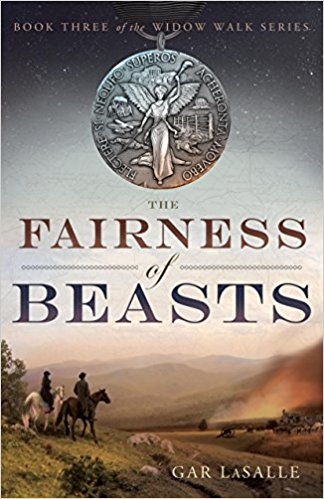
Gar LaSalle
Solipsis Publishing
Softcover $17.95 (357pp)
978-0-9978436-1-3
Buy: Local Bookstore (Bookshop)
Gar LaSalle’s third book in the Widow Walk series, The Fairness of Beasts, moves a sprawling family saga into the drawing rooms and battlegrounds of a people divided.
The year is 1862. Geographic distance and family rifts emerge from the Civil War’s darkness to threaten Emmy O’Malley Evers’s kith and kin. As they try to survive all that divides them, Emmy scrambles to navigate a personal war, aware that, decision or indecision, some relationships may be severed forever.
The daughter of a Democratic congressman from Massachusetts, Emmy has had access to money and power all her life, but recent experience has seasoned her. Twice widowed, she is a survivor. Now she is reunited with her family and living in Washington, DC. Her beau, physician Rory Brett, waits behind Southern lines for an answer to his proposal.
As the war escalates, communication evaporates, and Emmy’s family is once again endangered when she leaves her children behind to embark on an extraction mission, unsure if she’s guided by head or heart.
Emmy is a flawed heroine whose strength seems brittle, perhaps due to all she’s survived. But this is more than Emmy’s story. The novel uses multiple points of view and explores the lives of each character who crosses Emmy’s path. Sexual victimization of children, physical and psychological violence, and the pedestrian abuse of power are significant themes and make for harrowing reading.
When the characters’ problematic choices coalesce with the savagery of war, the outcomes are heartbreaking and often horrifying, “without so much as anything that resembles even a bit of the fairness accorded to beasts.” Gar LaSalle’s diligent use of historical events and locations serve as a frequent reminder that this fiction is moored in a bloody past that none were able to outrun or escape.
LETITIA MONTGOMERY-RODGERS (October 27, 2017)
March 1917
The Red Wheel, Node III, Book 1
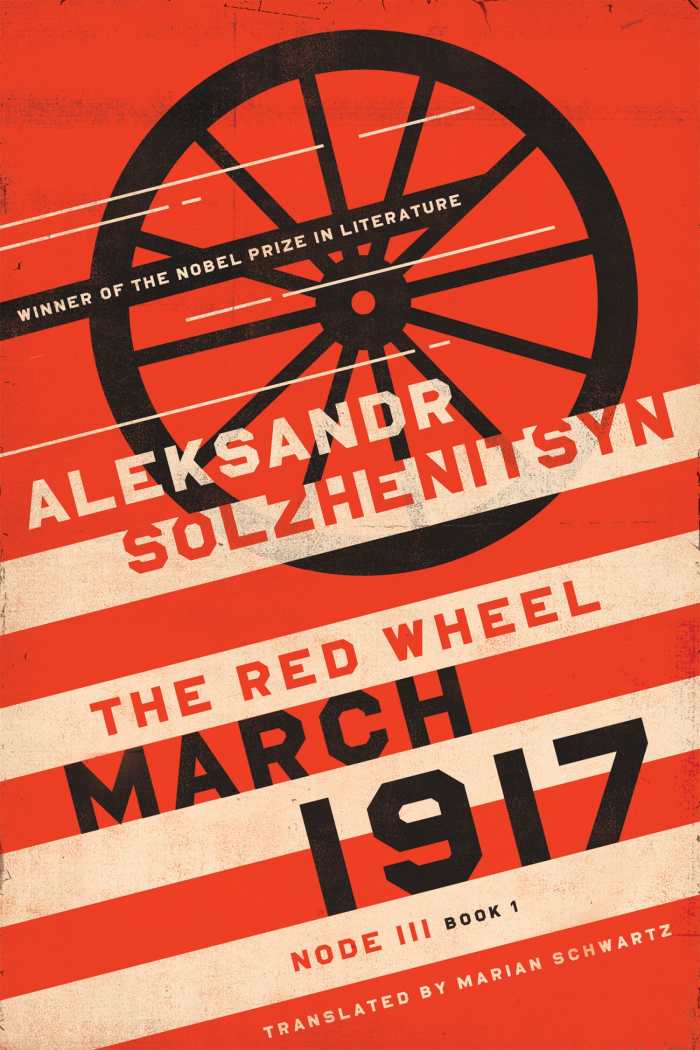
Aleksandr Solzhenitsyn
University of Notre Dame Press
Hardcover $39.00 (672pp)
978-0-268-10265-4
Buy: Local Bookstore (Bookshop)
In commemoration of the one-hundredth anniversary of the Russian Revolution, the University of Notre Dame Press is releasing the first English translation of Nobel Prize-winner Aleksandr Solzhenitsyn’s epic work, March 1917, Node III, Book 1 of The Red Wheel, translated by Marian Schwartz.
Described by Solzhenitsyn as “a narrative in discrete periods of time,” The Red Wheel is comprised of four nodes. Divided into four books, March 1917 spans a single month of the Russian Revolution; Book 1 covers the events of March 8–12, 1917, the period during which Russia’s empire began to crumble.
With its cast of over fifty people, The Red Wheel offers unparalleled access to a wide range of viewpoints and experiences. It shatters the monolithic depiction of war and political movements in favor of a deeply fractured, multifaceted, often labyrinthine narrative. While some people are dying, others are conducting love affairs, recovering from illness, engaging in political lobbying, shopping, writing letters, mourning their dead, or scheming. In other words, the business of living is the work of the living, even, and maybe especially, in times of political chaos and war.
Histories tend to collapse events into a single narrative; Solzhenitsyn insists on plurality. He explodes the Russian Revolution back into myriad voices and parts, disarrayed and chaotic, detailed and tumultuous. Combining historical research with newspaper headlines, street action, cinematic screenplay, and fictional characterization, the book is as immersive as binge-worthy television, no little thanks to this excellent translation that renders its prose as masterful in English as it was in Russian.
In March 1917, Solzhenitsyn attempts the impossible and succeeds, evoking a fully formed world through episodic narratives that insist on the prosaic integrity of every life, from tsars to peasants. What emerges is a rich history that’s truly greater than the sum of its parts.
LETITIA MONTGOMERY-RODGERS (October 25, 2017)
Strangers in Budapest
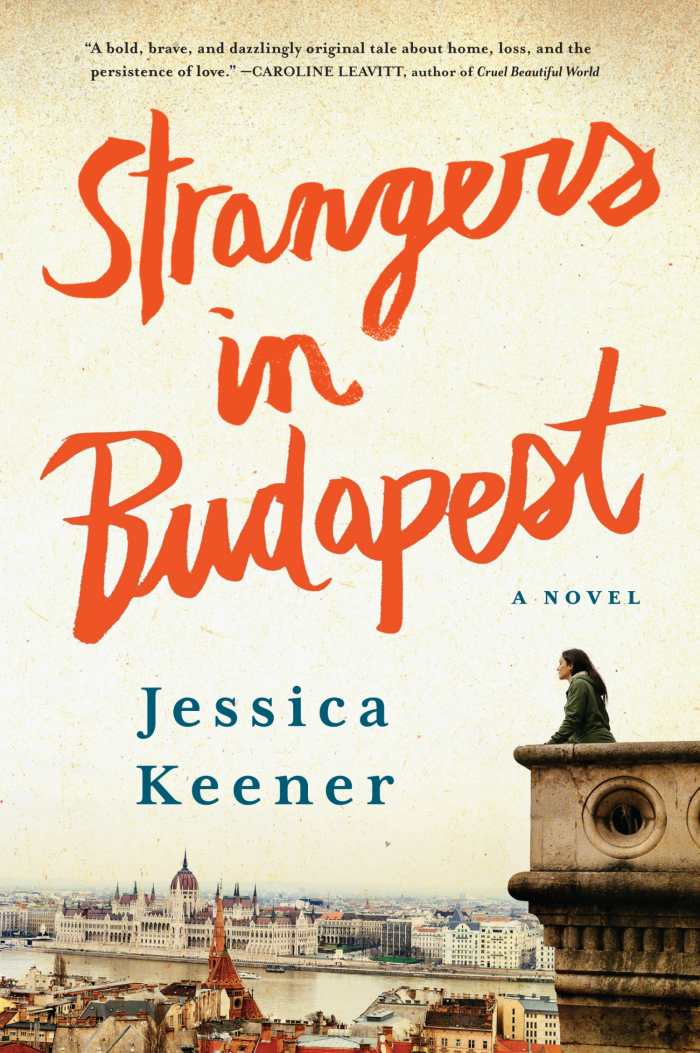
Jessica Keener
Algonquin
Hardcover $26.95 (352pp)
978-1-61620-497-6
In Jessica Keener’s Strangers in Budapest, it’s 1995, and the tech bubble is swelling. The Wall Street Journal is reporting unprecedented opportunity in Eastern Europe, and three Americans—Annie, Will, and their 4-month-old, newly adopted son, Leo—ride that tide of optimism from suburban Massachusetts to Hungary. Soon, they’ll discover what Hungarians have always known: behind the city’s “preserved exterior hid[es] a darker, rundown interior—beauty and ugliness coexisting, each one vying for dominance.”
Will is chasing an entrepreneurial dream, and Annie is following along, happy to escape the prying eyes of their adoption agency for the chance to be a regular family. But after several months in Budapest, they’re spinning their wheels. Each is furtively casting about for something to fill the growing void when a letter from old neighbors—themselves Hungarians—send them to a small apartment to check on Edward Weiss, an elderly American ex-pat who’s clearly in poor health but insists that no one should know he’s there. Will’s dismissive, but Annie can’t let this haunted man go.
Annie’s a runner—literally and figuratively. As she circumnavigates Budapest, she’s also circling a past she’d like to leave behind. All that’s unresolved inside her pulls her toward other people’s tragedies like iron filings to a magnet, the “pull of ‘helping’ drawing her.” And there are plenty of people for her to snag against. Budapest’s an ominous, atmospheric city that resists—foreign development, easy communication, gentrification—all the can-do, progressive insistence and positive facades of the visiting Americans.
In Keener’s Strangers in Budapest, the city is as much a character as any, and as Annie and others begin to cave under it’s crumbling weight, what’s revealed where East meets West is a story about the implacability of the past—present, progress, and denials notwithstanding.
LETITIA MONTGOMERY-RODGERS (October 27, 2017)
A History of the Church in 100 Objects
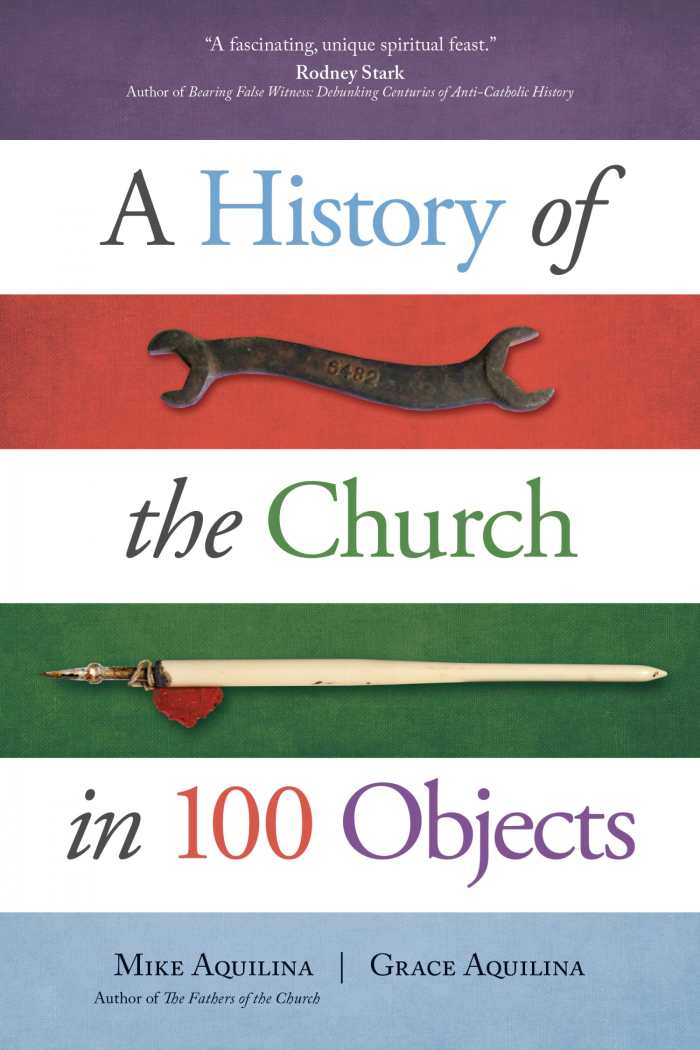
Mike Aquilina
Grace Aquilina
Ave Maria Press
Softcover $24.95 (256pp)
978-1-59471-750-5
Buy: Local Bookstore (Bookshop)
A panegyric to Catholicism, Mike and Grace Aquilina’s A History of the Church in 100 Objects surveys the Catholic Church’s history through its material culture. Declaring that “Catholicism is indeed a religion of ‘stuff,’” this book focuses the story of various objects as foundational in history’s construction as both artifice and artifact.
Dividing the book into seven historical eras, the stuff of Catholicism is distributed across the centuries and spans high and low art and culture. An illustrative physical object is the only hard qualifier for inclusion, so the hundred objects are highly varied. Each entry contains an image followed by a few brief, homily-like pages of text that situate each item within a larger historical religious context.
This book aims, first and foremost, at Catholic laity. It is transparent in this orientation, and the authors’ approach to Church history is straightforwardly conservative and orthodox. Thus, some items, like saint’s relics, are expected, and the accompanying text skews toward devotional.
Other inclusions, like a picture of bells in a bell tower, go unexpected places—in that particular case, to the Magna Carta and the foundation of modern democracy as an outcome of English Catholics rising up against an unjust ruler interdicted by the pope. Often intricate in its connections, world history is shown to be synonymous with Catholic history.
Stating that “artificiality is unavoidable, and divisions are inevitable—and helpful,” this book constructs, organizes, and showcases Catholic history and identity from the inside out. Its intimate perspective offers a broad sampling of Catholic sensibility in Western European social and religious history.
LETITIA MONTGOMERY-RODGERS (October 27, 2017)
In Search of the Phoenicians
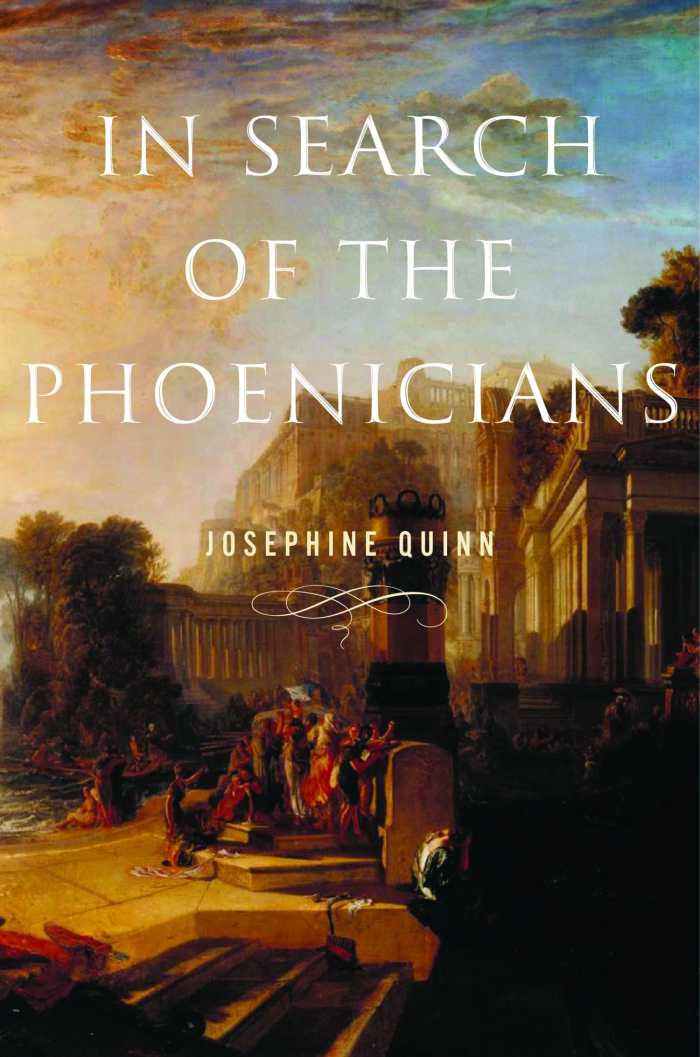
Josephine Quinn
Princeton University Press
Softcover $35.00 (360pp)
978-0-691-17527-0
Buy: Local Bookstore (Bookshop)
The Phoenicians left no surviving literature and relatively little material evidence of their existence, yet they were established explorers and traders before the emergence of the Greek and Roman empires. Who were these people we call “Phoenicians”? Josephine Quinn’s In Search of the Phoenicians argues in favor of an intricate, often politically expedient, identity that was and is read onto a group of people by those on the outside.
Quinn is methodical as she examines sites throughout the Mediterranean, Levant, and Atlantic ranging from Bronze Age to late-antiquity periods. By no means does she deny the existence of the Phoenician language or an ancient people referred to as Phoenicians. Rather, she examines ancient literary, epigraphic, numismatic, and artistic evidence to traduce the ways in which modern assumptions of ethnicity, nationhood, and collective identity may have caused the back-formation, rather than the discovery, of an ancient people.
An expansion of three lectures given at Tufts University, Quinn’s book challenges the notion of self-aware, collective Phoenician identity. The book’s three sections allow Quinn to drill down into specific, divergent areas of inquiry. By the conclusion, she’s explored topics as diverse as votive artifacts and funerary inscriptions (of which there are over ten thousand in Phoenician), Roman-Carthaginian antagonism, and modern nation building in places as disparate as Lebanon and Ireland, which grafted Phoenician roots onto their identity formations during their nascent nationalism.
Filled with informative, arresting images and deep-thinking argumentation, Quinn’s In Search of the Phoenicians makes a compelling, wide-ranging case that suggests “Phoenician” was a political rather than a personal description. As Quinn herself says, she’s arguing “from silence. A lack of evidence for collective identity is not evidence for its absence,” but it’s definitely an omission worthy of attention.
LETITIA MONTGOMERY-RODGERS (October 27, 2017)
Letitia Montgomery-Rogers

